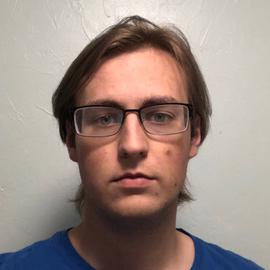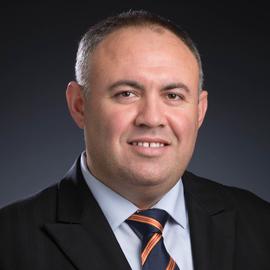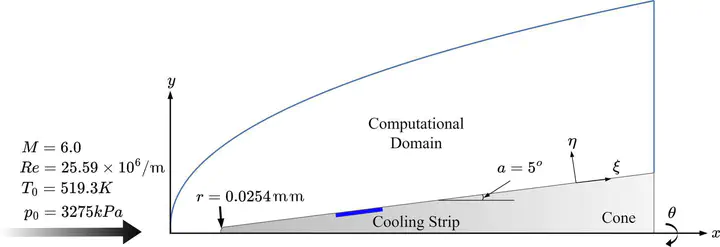Local Wall Cooling Effects on Hypersonic Boundary-Layer Stability
Furkan Oz, Thomas Goebel, Joe Jewell, Kursat Kara
October, 2022
Abstract
Hypersonic boundary-layer stability has significant importance in vehicle design and successful operation. This paper investigates the stabilization effects of local wall cooling on the hypersonic boundary layers over a 5 deg halfangle blunt cone with a nose radius of 0.0254 mm. We employed a high-order-accurate flow solver to calculate the steady flow for a freestream Mach number of 6.0 and a unit Reynolds number of 25.59×10^6∕m. In simulations, we considered partial wall cooling, entire wall cooling, and adiabatic wall scenarios. Furthermore, we examined partial cooling parameters such as strip location, length, and temperature profiles. We calculated the growth rates, phase speed, and N-factor diagrams using a linear stability analysis. The results showed that complete wall cooling destabilizes the boundary layer. However, the cooling strip upstream of the synchronization point stabilized the boundary layer by damping the disturbances. The longer cooling strip further stabilized the boundary layer. The cooling strip placed downstream of the synchronization point destabilized the boundary layer.
Publication
Journal of Spacecraft and Rockets

Furkan Oz
Ph.D., Current Position: Oak Ridge National Laboratory

Thomas Goebel
Undergraduate Researcher

Kursat Kara
Associate Professor, Mechanical and Aerospace Engineering
Kursat Kara is an Associate Professor of Mechanical and Aerospace Engineering at Oklahoma State University and principal investigator of the Kara Aerodynamics Research Laboratory. His research spans hypersonic boundary-layer physics, unsteady aerodynamics, and the emerging interface of quantum computing and fluid dynamics. A dedicated educator and mentor, he teaches core and advanced courses—including Fundamentals of Aerodynamics, Computational Fluid Dynamics, Boundary-Layer Theory and Transition, and Quantum Computing—and supervises graduate and undergraduate projects in high-fidelity simulation and data-driven modeling. His work has been funded by NASA, NSF, Oklahoma NASA-EPSCoR, NAVAIR, ANSYS, and IBM Quantum. In 2025, he received the CEAT Excellent Faculty Award and was nominated for both the 2024 Excellent Teacher Award and the 2025 Excellent Faculty Award by OSU’s School of Mechanical and Aerospace Engineering. Dr. Kara earned his Ph.D. from Old Dominion University with a dissertation on hypersonic boundary layer receptivity to acoustic disturbances. He began his career as a research engineer at New England Analytics (supporting Sikorsky Aircraft), then completed a post-doctoral appointment at Penn State in hot jet simulations for aeroacoustics. In 2010, he helped establish the Aerospace Engineering Department at Khalifa University—where he won the President’s Faculty Excellence Award for Outstanding Teaching in 2015—before joining OSU. An active member of AIAA and APS, he served on the AIAA Applied Aerodynamics Technical Committee (2012–2021) and chaired/co-chaired multiple AIAA conferences. He also sits on the editorial board of Nature Scientific Reports and guest-edits its Quantum Computing collection.
